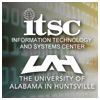Intercomparison of candidate methods for mineral dust aerosol classification using MODIS infrared and visible channels
| Title | Intercomparison of candidate methods for mineral dust aerosol classification using MODIS infrared and visible channels |
| Publication Type | Conference Paper |
| Year of Publication | 2009 |
| Authors | Duvall, A, Ramachandran, R |
| Conference Name | 17th International Conference on Geoinformatics |
| Date Published | 12-14 Aug. 2009 |
| Conference Location | Fairfax, VA |
| ISBN Number | 978-1-4244-4562-2 |
| Keywords | UAH |
| Abstract | The Geoinformatics Group at the University of Alabama in Huntsville (UAH) Information Technology and Systems Center (ITSC) conducts a broad range of informatics research including data mining, metadata development, and ontology/semantics modeling. Within the data mining arena, an automated dust storm detection system is under development using ITSC's remote sensing data visualization and analysis tool, ADaM-IVICS. In this study, a reference supervised classification method was used as a baseline for comparison against a threshold based heuristic classifier designed to distinguish clouds from airborne mineral dust in selected Terra MODIS Level 1B imagery. The reference classification method couples an Orthogonal Forward Selection (OFS) optimization algorithm and a Naive Bayes (NB) classifier on training samples to determine the optimal spectral bands. The NB classifier then uses the selected subset of spectral bands to detect dust. The threshold-based classifier used is implemented as a Decision Tree and based on the Integrated Dust Detection (IDD) method. The IDD method calculates D*, a dust index based on infrared bands suitable for both daytime and nighttime dust detection. Incorporating NDVI to improve the demarcation between land and ocean surfaces obscured and un-obscured by dust refined the IDD method. Additional thresholds were derived using combination of both D* and NDVI to improve the classification accuracy. Classification results from the threshold-based algorithm are compared to reference results and are presented in this paper. |
| URL | http://ieeexplore.ieee.org/xpl/freeabs_all.jsp?arnumber=5292935 |
| DOI | 10.1109/GEOINFORMATICS.2009.5292935 |
Involved Persons:
- Log in to post comments
- Google Scholar
- DOI




